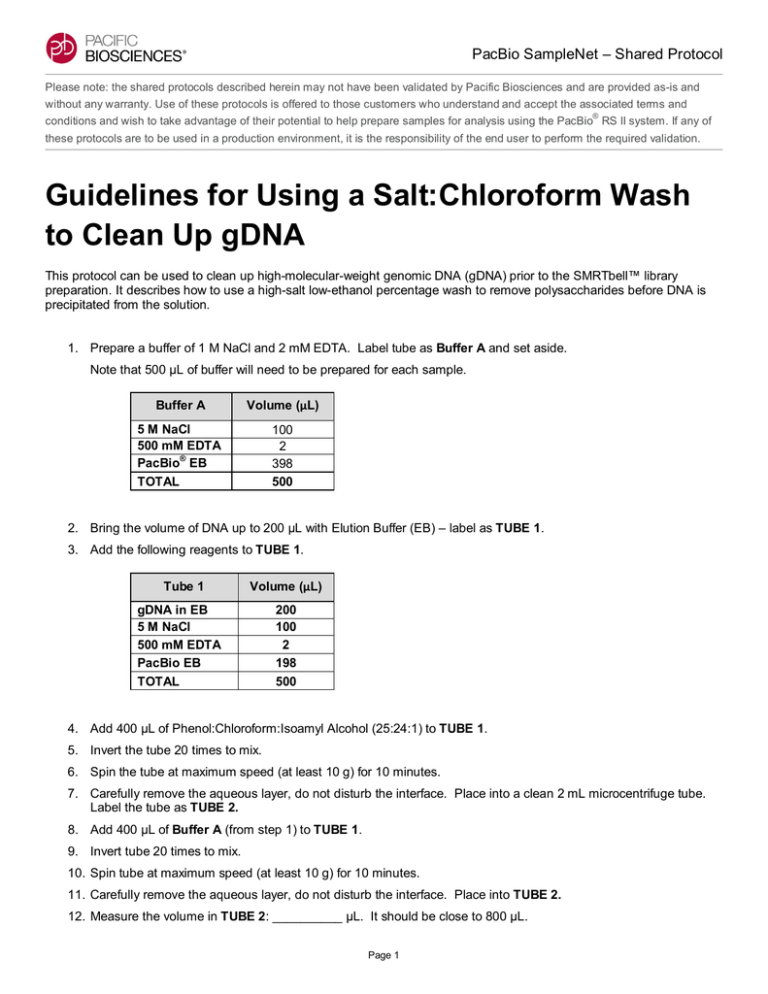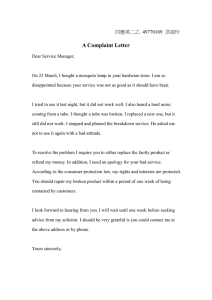
PacBio SampleNet – Shared Protocol
Please note: the shared protocols described herein may not have been validated by Pacific Biosciences and are provided as-is and
without any warranty. Use of these protocols is offered to those customers who understand and accept the associated terms and
®
conditions and wish to take advantage of their potential to help prepare samples for analysis using the PacBio RS II system. If any of
these protocols are to be used in a production environment, it is the responsibility of the end user to perform the required validation.
Guidelines for Using a Salt:Chloroform Wash
to Clean Up gDNA
This protocol can be used to clean up high-molecular-weight genomic DNA (gDNA) prior to the SMRTbell™ library
preparation. It describes how to use a high-salt low-ethanol percentage wash to remove polysaccharides before DNA is
precipitated from the solution.
1. Prepare a buffer of 1 M NaCl and 2 mM EDTA. Label tube as Buffer A and set aside.
Note that 500 µL of buffer will need to be prepared for each sample.
Buffer A
Volume (µL)
5 M NaCl
500 mM EDTA
PacBio® EB
TOTAL
100
2
398
500
2. Bring the volume of DNA up to 200 µL with Elution Buffer (EB) – label as TUBE 1.
3. Add the following reagents to TUBE 1.
Tube 1
Volume (µL)
gDNA in EB
5 M NaCl
500 mM EDTA
PacBio EB
TOTAL
200
100
2
198
500
4. Add 400 µL of Phenol:Chloroform:Isoamyl Alcohol (25:24:1) to TUBE 1.
5. Invert the tube 20 times to mix.
6. Spin the tube at maximum speed (at least 10 g) for 10 minutes.
7. Carefully remove the aqueous layer, do not disturb the interface. Place into a clean 2 mL microcentrifuge tube.
Label the tube as TUBE 2.
8. Add 400 µL of Buffer A (from step 1) to TUBE 1.
9. Invert tube 20 times to mix.
10. Spin tube at maximum speed (at least 10 g) for 10 minutes.
11. Carefully remove the aqueous layer, do not disturb the interface. Place into TUBE 2.
12. Measure the volume in TUBE 2: __________ µL. It should be close to 800 µL.
Page 1
PacBio SampleNet – Shared Protocol
13. Add an equal volume of Chloroform:Isoamyl Alcohol (24:1) to TUBE 2.
14. Invert tube 20 times to mix.
15. Spin tube at maximum speed (at least 10g) for 10 minutes.
16. Carefully remove the aqueous layer, do not disturb the interface. Place into a clean 2 mL microcentrifuge tube.
Label the tube as TUBE 3.
17. Measure the volume in TUBE 3: __________ µL.
18. Add 0.3X volume of ethanol (99.99%) to TUBE 3. This high-salt, low-ethanol mixture precipitates the excess
polysaccharides while gDNA remains in the solution. _______ µl (TUBE 3) x 0.3 = _________ µL of Ethanol
19. Invert tube 20 times to mix.
20. Spin tube at maximum speed (at least 10 g) for 15 minutes.
21. Carefully remove the supernatant without disturbing the polysaccharide pellet. (Note that no visible pellet may be
seen at this step). Place supernatant into a clean 2 mL microcentrifuge tube. Label the tube as TUBE 4 and
measure the volume. Note: TUBE 4 contains the gDNA.
22. Add 1.7X volume of ethanol (99.99%) to TUBE 4. The gDNA can be seen as falling out of the solution as long
strands of gDNA; _______ µl (TUBE 4) x 1.7 = _________ µL of Ethanol.
23. Invert tube 20 times to mix.
24. Spin tube at maximum speed (at least 10 g) for 15 minutes.
25. Add 500 µL of 70% ethanol to remove the excess salt; do not disturb the pellet.
26. Spin the tube at maximum speed (at least 10 g) for 15 minutes.
27. Carefully remove supernatant, do not disturb the pellet. Save supernatant in a clean tube (label as TUBE 5).
28. Add 500 µL of 70% ethanol to remove the excess salt; do not disturb the pellet.
29. Spin the tube at maximum speed (at least 10 g) for 15 minutes.
30. Carefully remove the supernatant; do not disturb the pellet. Add supernatant to TUBE 5. Quick spin to gather the
residual ethanol at the bottom of the tube and carefully remove with a P20 tip.
31. Let pellet air dry for 5 min at room temperature, taking care not to over dry.
32. Resuspend the pellet in 100 µL TE. Incubate at 4ºC with gently mixing overnight to resuspend. Store at 4ºC for
use within one week, or store at -80ºC for long-term storage.
33. Perform a 1X AMPure® Bead purification step and resuspend the DNA in PacBio EB immediately before shearing.
For Research Use Only. Not for use in diagnostic procedures. © Copyright 2014, Pacific Biosciences of California, Inc. All rights reserved. Information in this document is
subject to change without notice. Pacific Biosciences assumes no responsibility for any errors or omissions in this document. Certain notices, terms, conditions and/or use
restrictions may pertain to your use of Pacific Biosciences products and/or third party products. Please refer to the applicable Pacific Biosciences Terms and Conditions of
Sale and to the applicable license terms at http://www.pacificbiosciences.com/licenses.html. Pacific Biosciences, the Pacific Biosciences logo, PacBio, SMRT, SMRTbell, and
Iso-Seq are trademarks of Pacific Biosciences in the United States and/or certain other countries. All other trademarks are the sole property of their respective owners.
Page 2




